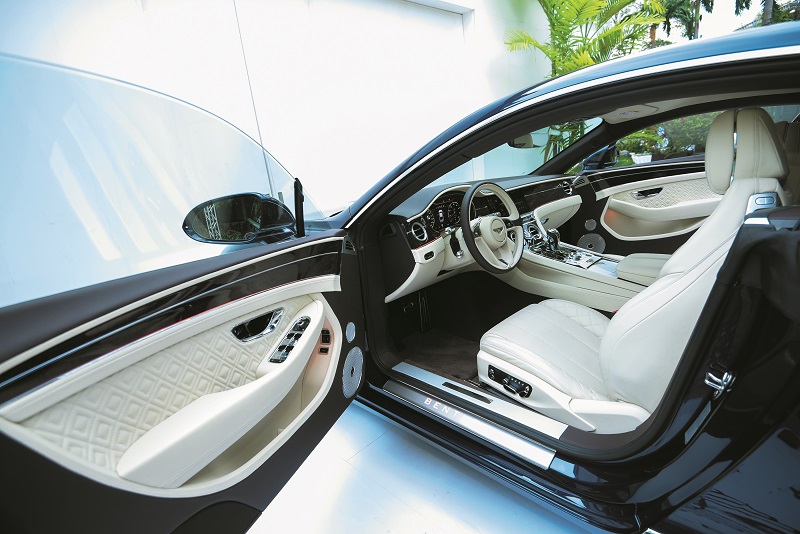
Three lines. That’s all a designer needs to draw a car, if its shape is pure and timeless.
Which is exactly what John Paul Gregory produced on the back of a menu in the Brasserie of Singapore’s Fullerton Hotel — the unmistakably sleek but brutish outlines of the new Bentley Continental GT, fresh from its debut at the Frankfurt Motor Show.
It’s a sign of the times that a motor of this pedigree and price is shuttled off not to the traditional markets of the Middle East or Europe, but instead to the Far East. Where, not coincidentally, the Singapore F1 race weekend was about to start, and journalists, petrolheads and millionaires had gathered to pay homage to horsepower and freedom.
And what better place to launch Bentley’s new Grand Tourer than in the rarefied atmosphere of the Fullerton, once a post office but today a genteel, luxury bolthole for monied visitors to wealthy Singapore, the exact target market for Bentley’s brand attributes of money, power, privilege and exclusivity?
Price lists for the new GT have yet to be released, but the outgoing Continental started at a base price of about S$700,000, or around RM2.2 million, which rapidly multiplies once optional extras and Mulliner (read: bespoke) additions are tacked on. So what does one get for that kind of coin?

For a start, the most lascivious motor design since the Lamborghini Miura, thanks to the input of Gregory, who also designed Bentley’s Speed 6. For another, a massive 6.0 litre twin-turbo TSI mill configured in a “W” formation that produces 626 brake horsepower and 900 NM of torque — which, if we were allowed to drive (we weren’t), would propel us and the escargots and wagyu rib-eye bathed in “Café de Paris” sauce we had just consumed to 60mph in 3.6 seconds and on to an ultimate speed of 207mph.
But the GT wasn’t here to stretch its legs on Singapore’s street circuit. It was shuttled here to book sales. And squatting there on its pedestal, gleaming like some digital carnivore, it looked like it was worth every cent of the incredible money it was asking.
‘Don’t mess it up’
The difference between brands like Bentley versus, say, Lexus — which has just launched its own iteration of a luxury coupe, its LC500 — is heritage. Or specifically, the need to maintain a design lineage to its forebears, unlike Lexus or its more junior, downmarket brand Toyota, who almost always sketch from a clean slate for each model rollout.
In Bentley’s case, the new GT offers clear reminiscences to the R-Type Saloon of 1954, necessitated by a design rulebook that dictates that model updates to grand-dame marques like Bentley are always evolutions of existing design codes. That’s never a bad thing, except that the rule is “to not mess it up”, says Gregory, whose affable nature nicely contradicts the notion that Britishers with triple-barrelled names are stuffy and unapproachable.
“Other brands enjoy the zeitgeist, producing designs that speak to the contemporary, but Bentley doesn’t have that privilege,” the 37-year-old notes. “The trick for us [and Bentley’s director of design Stefan Sielaff] is always to produce designs that can be instantly recognisable but still be unique.”
That approach has helped Bentley to produce a design that is achingly and stunningly beautiful. It’s the kind of car that sways the most disciplined into parting with a couple of million ringgit for the privilege of owning a future classic. Which, one might add, is the Holy Grail of automotive design.
Precious few makes are capable of producing instant classics — Alfa’s 8C is one example, Aston’s DB11 is another — but not many others. Bentley missed the mark — badly — with its Bentayga, but got it absolutely right with the Continental GT, maintaining the low, brutish stance of its predecessor, but thoroughly updating the range using aerospace technology called “Superforming” to give it a clean aesthetic that evokes speed, class and presence even while inert.
“[The Continental]’s a thug in a suit,” says Gregory. “A bit like Michael Caine in Get Carter, but with a lot more money and presence.”
Pièce de résistance
Once you’ve recovered your composure, prepare to lose it again inside the Bentley’s interior, where the attention to detail is just outstanding. Bentley owners will recognise the fascia’s shape, inspired as always by the wings of the Bentley badge. It sweeps up from an elegant centre console and reaches out towards the doors, bathed as one is in a never-ending cocktail of handcrafted leather and wood.
At this level, customisation is almost de rigueur and, well aware of this, Bentley offers dual-veneer options where you can take your pick from from Dark Fiddleback Eucalyptus, Dark Stained Madrona, Liquid Amber or Tamo Ash and pair it with a mirror-like Piano Black finish.

Single veneer options number eight in all, including Koa, a mid-tone, straight-grained veneer from Hawaii, normally used in surfboards and guitars. The customisation extends to the console, which can be commissioned with a rippled 0.6mm aluminium finish called “Côtes de Genève”, inspired by the milled internal casings of fine watches.
Decorative features like the clock bezels and bulls-eye air vents can also be commissioned with diamond knurling — a jewellery-inspired texture composed of a myriad diamond-shaped flat surfaces.
The pièce de résistance, however, is Bentley’s fully digital, driver-focused instrument panel, which boasts an industry-first “rotating display” featuring a colossal 12.3-inch touchscreen housed in a three-sided unit.
Inspired by the Bond cars of yesteryear — Aston Martins that featured rotating number plates to escape from baddies — the revolving veneer offers the touchscreen as well as three elegant analogue dials once one gets teched-out. Bentley’s design director and Gregory’s boss, Sielaff, is German, but is “hopelessly and utterly Anglophile in nature”, admits Gregory.
Hence the Bond touches, which are the epitome of Britishness: a wink of the eye, a touch of humour and more than a bit of aplomb thrown into the mix. In all, there are three “pages”: the decoration surface, the information screen and the three analogue clocks, which is the unexpected and delightful surprise.
What’s next?
Gregory notes, correctly, that the car industry is currently in a massive state of flux, upended by the internet and the entry of new players like Apple, Tesla and Google. His neck of the woods is, of course, design, and the question in his circles and among his peers are: Should electric vehicles (EVs) look different?
In EVs, of course, there are no engines, just batteries. So the differentiator other than performance remains design, which is a domain, he acknowledges, where brands haven’t done as much as they can on the clean slate they have been offered. But from Bentley’s standpoint, while one design direction is mobility, another is emotion.
“Fundamentally, we’re all human — we want to feel like we’re doing well,” he says. “Our challenge is to always raise the stakes in offering a luxurious experience that fills customer needs for a toy.”
Judging from Mercedes-Maybach’s Vision 6 Cabriolet, which appeared at the Pebble Beach Concours d’Elegance in California, the US, last month, that future, while all-electric, is “likely to be phallic in nature, a return to the liquid, glamorous shapes of the Thirties”, Gregory notes, with a British twinkle of the eye.
Just like the Vision 6’s power-train (four electric motors, 550kW and 0-60mph in under four seconds), the auto industry is facing increasing pressure to be more environmentally conscious and sustainable.
Sitting in the hushed cabin of the Bentley, festooned as it is with acres of wood and leather (how many trees and cows were felled to fill this cabin, I wondered), one is equal parts saddened and curious at the prospect of the car cabins of the future being instead adorned with vegan materials. How will they feel? How will they smell?
The future is scary then, but exciting.
For a car company that feels and behaves like an underdog and whose design director is an Anglophile with a German name and exterior — indeed, for the Continental’s designer Gregory, whose grail cars are the Ferrari 288 GTO and Porsche 911 GT — two massive icons of design and engineering — customers can probably expect fresh and exciting new directions from this most British of brands.
If the Continental GT is any indication, that direction warrants breathless expectation.


